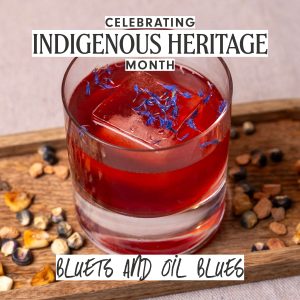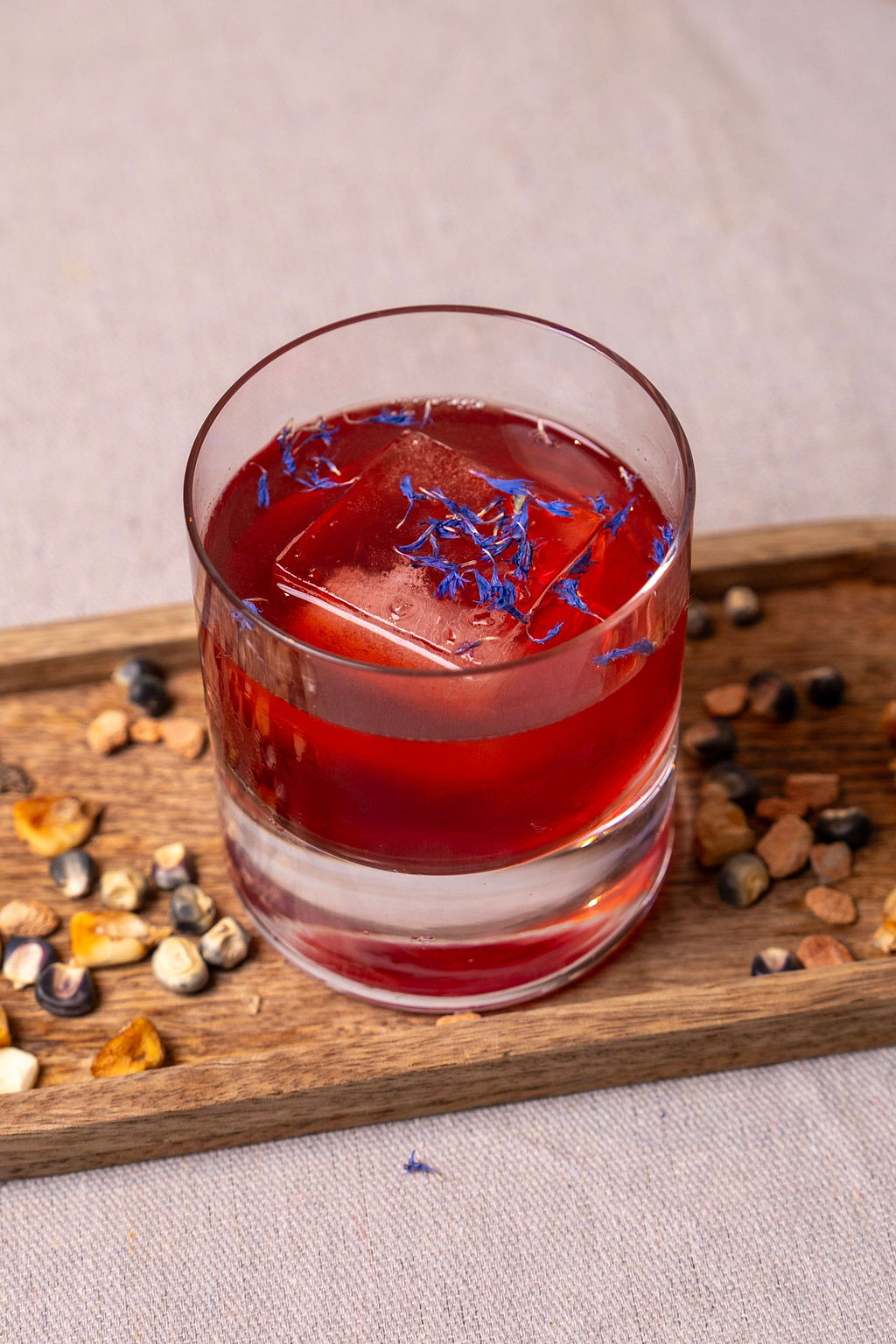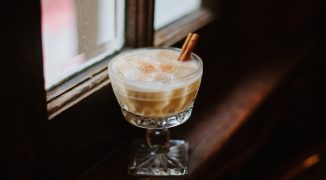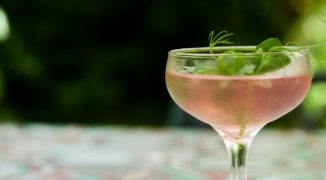How to Invite Us In on Stolen Land
 By Acadia Cerise
By Acadia Cerise
I want to welcome you in. Cozy up at the bar. Let your feet touch grass. Stay for a little while. Long Day? Do you also wonder how we do better than survive, but thrive as a whole? Open your mind to the possibility that we are all, in fact, relatives here; Mitákuye Oyásʼiŋ.
What kind of drink would you like? Oh, and before you look at me funny, or someone makes a dark joke in passing about how I have a great job if you want to get paid for partying, but it’s risky as a Native Person… the clear and staggering implication.
To put it bluntly – after numerous studies, there is no proof to support the Fire-Water myth, or the role of genetics in Alcoholism regarding Native Americans vs. Europeans. There have also been fermented beverages in the Americas for thousands of years. I implore you to go read the pieces previously featured from my esteemed colleagues and fellow Native Baddies, Chockie Tom, Roxanne Fernandez Tiburolobo, and Danielle Goldtooth on the matter.
The very same law that banned distilleries on tribal lands in 1834 also banned the legal sale of alcohol on reservations due to these falsehoods creating greater disparity and stigma. In fact, there is one singular external indicator outside of trauma and abuse on how likely one will be to fall into a dangerous relationship with booze: Poverty. A reality that could strike any one of us. Poverty that was also forced on many by the taking of lands and food sources.
Nevertheless, this persistent urban legend was told to me very young. Growing up, it directly affected my own understanding of drinking, witnessing some of the men in my Lakota & Irish side of the Family slip in and out of addiction and oblivion, or be absent altogether. It is a large reason I have always had a Non-Alcoholic option available to those at the programs and events I have created since.
In a world in which less quiet racism is on the rise, we need allies more than ever (how to be one is going to differ significantly from person to person, so it is best to ask directly). I am personally hoping we may take the time to interrogate the subtle influence on our collective perception of Natives from the pervasive and singular caricatures that can be found in sport mascots, tobacco brands, butter, cartoons, and the classic Cowboy vs. Indian movies or games. To more successfully create safe and comfortable spaces in our industry, I often point to the way some have listened to the voices of Pacific Islanders and Hawaii Natives in operating Tiki, or Modern Tropical Bar programs that leave out the bastardized gods, totems, sexualized women and other previously accepted, but problematic aspects that do not truly aim to celebrate this culture.
I have heard that the underlying impetus of Manifest Destiny in “Killing the Native (Savage) to Save the Man”, which was a decree that stated our peoples as less than humans, something to be saved by “Civilized”, Christian, and most importantly White Men. A good enough reason to dismiss values that focus on being a good ancestor for generations rather than reaping as much as one can in resources and currency in one lifetime. Yet we still exist today all around you, even if some are separated from our culture. Only 7.4 million people claim Alaskan or American Native inside of the U.S. Census Bureau but others estimate the numbers to be over 10 million. That would be more than the entire population of New York City. Inside of that there are 574 federally recognized tribes and even more who didn’t have the privilege of recognition.
However, now that we have put all of that aside, we may be able to approach the good things.
In the past decade, Farm-to-Table Restaurants, Zero Waste, and Sustainability have been buzz words floating around in Tales, 50 Best Bars, and Hospitality as a whole. When ancestral drinks from Mexico are on the rise and growing in popularity, it is also crucial to consider how much was taught by our indigenous people to others to begin with. I can remember the lessons taught to me by elders about how important it is to honor a bison when it gives its life to you, and how we may do that by using every last gift of cartilage, flesh and bone with great purpose and grace. Like many things that are not unanimous among all tribes, and can be a bit of a trope as well, however, these things have informed my life choices.
So many Tribal Nations (recognized by the U.S., Canadian or Mexican government or otherwise) have been using biodynamic farming with Milpa or the Three Sisters for thousands of years. These things are prized in wine-making and delicious produce. In the scope of these contributions, what good excuse is there to not be working closely with our peoples? Some who hold roles as Generational Seed Keepers, running Food Sovereignty and Native Foraging projects. It is critical as we aim to resist rampant mono-cropping losing flavor, quality and even clean Water rights to large corporations.
To discuss Food and Beverage without the lens of Colonialism is to rob our industry of real History. To me, this also means failing to find ways to bridge these gaps, collaborate and create progress appropriately. To dismiss the very invention of rum by Slaves using sugarcane — previously taken from the Pacific Islands and India — and then have that very same rum sold to the companies that made their fortune in the Slave trade. It is to pretend that tomatoes, corn, or beans were ever in Europe prior to the 16th Century. The red fruits of one were originally feared to be poisonous, and are now considered staples of Italian cuisines, erasing the many Natives of the Americas who brought them such once again./
In the words of Native Historian, and fellow Lakota, Nick Estes:
“Indigenous resistance is not a one-time event. It continually asks: What proliferates in the absence of empire? Thus, it defines freedom not as the absence of settler colonialism, but as the amplified presence of Indigenous life and just relations with human and nonhuman relatives, and with the earth.”
All things are related. If we want to continue to build spaces where we are asked with consideration that our ceremonies or sacred ingredients are not used as a cocktail garnish, we must recognize that many in our community are experts in their own right. Here, perhaps we can all dream of an earth where: we sit at the same bar space comfortably, more than over 20 types of legumes are grown again, the pawpaws are bountiful across the East Coast, and the buffalo roam free in the Black Hills and Turtle Island once more.
We are here, as we always have been. Invite us in.

 Bluets & Oil Blues
Bluets & Oil Blues
- 1.25oz Rosaluna Mezcal
- 0.75oz Chickory-infused Abasolo Heirloom Corn Whiskey
- 1oz Blue Corn Honey Syrup
- 0.75oz Aronia Berry Liqueur
- 3 drops Lactic Acid
- 1 dash Eastern Black Walnut Bitters
I previously created this drink as an exercise to see if I could create a drink without any ingredients that would not have been found in the Americas pre-colonization, which meant removing Citrus, which was originally from China and the Himalayas and some other usual suspects.
It was a fun challenge that found a home at the Premiere of Killers of the Flower Moon (many thanks to Paramount and Nick Dodge for the opportunity, with proceeds going to the Indigenous Women Rising Charity).






